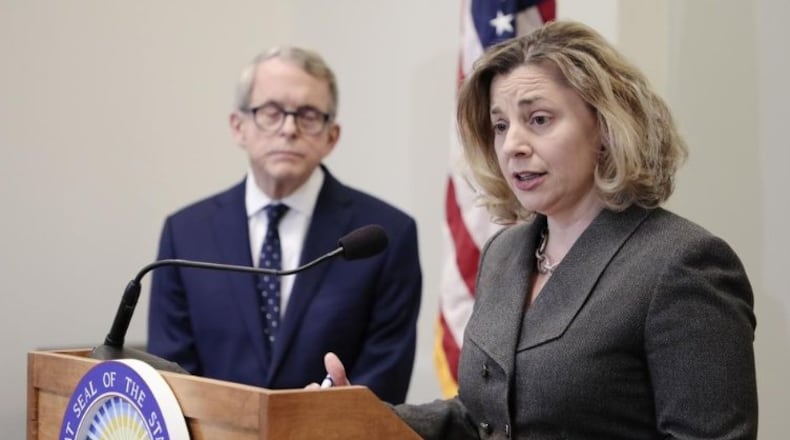State Sen. Matt Dolan, R-Chagrin Falls, chair of the Senate Finance Committee, said legislators plan to hold discussions “in earnest” next week and aim to pass the capital budget on June 1.
More than $2.7 billion of the total is expected to come from sale of state bonds. State bonds usually have a repayment period of 15 to 20 years, Murnieks said.
The remaining $594 million will come from other sources, including some from the federal American Rescue Plan Act. The capital budget would cover the two-year period which ends June 30, 2024.
The capital budget is used for renovation or construction projects at state-owned buildings, school districts and public colleges; infrastructure grants and loans to local governments; and direct funding of “community projects of local or regional importance.”
Murnieks framed much of the spending as for infrastructure that will create or support jobs. The 200 or so capital projects the state oversees at any given time provide more than 12,000 design or construction jobs, she said.
Local projects
In the Senate Finance Committee, state Sen. Vernon Sykes, D-Akron, said the budget proposes less for community projects than the previous capital spending plan.
Murnieks said the capital budget discussion usually starts with a placeholder amount of $150 million for community projects. That has risen to $163.5 million so far, but she expects “continued conversation.”
Community projects on the statewide list include mental health and drug treatment facilities, facilities for people with developmental disabilities, parks, recreation and conservation projects, historical and cultural facilities and agricultural society improvements.
Legislators worked with community representatives to identify priority projects, but the list is not finalized, according to Murnieks’ presentation.
In the House Finance Committee, state Rep. Thomas West, D-Canton, asked Murnieks whether the maximum amount of ARPA dollars was going toward community projects. She replied that the federal money is being used mostly at the state level because it comes with extensive reporting requirements, so more flexible state dollars are used for local projects.
“When you are giving (local governments) ARPA dollars, you are also giving them a reporting headache,” Murnieks said.
Rep. Dontavious Jarrells, D-Columbus, noted that a report last year from the Natural Resources Defense Council estimated there are still 650,000 lead drinking-water pipes in Ohio soil. Removing them should be a “standing item” in the capital budget until they’re all replaced, he said.
Murnieks said lead pipes have to be specifically identified then removed. The Ohio EPA has given community grants to find lead pipes, and part of the H2Ohio budget can be used for their removal. More federal funding is expected for lead pipe replacement, she said.
Breakdown of uses
The proposal would appropriate $600 million for K-12 schools and $457 million for state colleges and universities. The latter includes $400 million for work on state campuses, based on priorities set by the state university system. The higher education funding also includes $22 million for student, faculty and researcher access to e-books and journals, and replacement of the 30-year-old statewide library management system.
Murnieks said the appropriation for K-12 schools will fund projects currently underway and 10 to 15 more. The state is about halfway through its list of school projects, she said.
Answering a question from state Rep. Tracy Richardson, R-Marysville, Murnieks said economically disadvantaged school districts are prioritized for funding.
The Department of Natural Resources would get $515 million, including money for upgrades to lodges, cabins, campgrounds, and playgrounds, and for dam rehabilitation projects. That sum includes $202 million in ARPA funds.
The Public Works Commission is expected to get $475 million, with $400 million of that going to local infrastructure needs: roads, bridges, water and sewer work. The remaining $75 million will go to the Clean Ohio Conservation Program to protect open spaces and watersheds.
The Department of Rehabilitation and Correction would get $353.3 million for work on its 28 prisons, 18 community-based residential treatment programs, and two halfway houses.
More than $103 million would go to the Department of Youth Services, with the bulk of that – $95 million – being used to replace the 55-year-old Cuyahoga Hills Juvenile Correctional Facility with a new 120-bed facility. Another $4.7 million would go to renovating the Circleville Medical and Administration facilities.
The Department of Agriculture is slated to get $86.4 million, of which $72 million in ARPA dollars would go for a new Animal Disease Diagnostic Laboratory, the only full-service veterinary diagnostic lab in the state, critical for stopping animal disease outbreaks, according to Murnieks’ presentation.
The Department of Mental Health and Addiction Services is slated to get $74.6 million for renovating state psychiatric hospitals and supporting recovery housing for the mentally ill and drug addicted.
About the Author

